One-Pot Synthesis of N-Doped NiO for Enhanced Photocatalytic CO2 Reduction with Efficient Charge Transfer
Abstract
:1. Introduction
2. Results and Discussion
2.1. Phase Structure
2.2. Microstructure
2.3. Optical Properties
2.4. Surface Chemical States
2.5. CO2-Photoreduction Performance
2.6. Evaluating the Separation Performance of Photogenerated Carriers
2.7. Energy-Band Structure
2.8. Possible Reaction Mechanism
3. Experimental Section
3.1. Materials
3.2. Synthesis of Precursor Ni(OH)2
3.3. Synthesis of NiO
3.4. Synthesis of N-NiO-x
3.5. Photocatalytic CO2 Reduction
3.6. Characterizations
4. Conclusions
Supplementary Materials
Author Contributions
Funding
Institutional Review Board Statement
Informed Consent Statement
Data Availability Statement
Conflicts of Interest
Sample Availability
References
- Tang, J.; Guo, R.; Zhou, W.; Huang, C.; Pan, W. Ball-Flower like NiO/g-C3N4 Heterojunction for Efficient Visible Light Photocatalytic CO2 Reduction. Appl. Catal. B-Environ. 2018, 237, 802–810. [Google Scholar] [CrossRef]
- Chen, S.; Yu, J.; Zhang, J. Enhanced Photocatalytic CO2 Reduction Activity of MOF-Derived ZnO/NiO Porous Hollow Spheres. J. CO2 Util. 2018, 24, 548–554. [Google Scholar] [CrossRef]
- Han, C.; Zhang, R.; Ye, Y.; Wang, L.; Ma, Z.; Su, F.; Xie, H.; Zhou, Y.; Wong, P.K.; Ye, L. Chainmail Co-Catalyst of NiO Shell-Encapsulated Ni for Improving Photocatalytic CO2 Reduction over g-C3N4. J. Mater. Chem. A 2019, 7, 9726–9735. [Google Scholar] [CrossRef]
- Hiragond, C.B.; Lee, J.; Kim, H.; Jung, J.W.; Cho, C.H.; In, S.I. A Novel N-Doped Graphene Oxide Enfolded Reduced Titania for Highly Stable and Selective Gas-Phase Photocatalytic CO2 Reduction into CH4: An in-Depth Study on the Interfacial Charge Transfer Mechanism. Chem. Eng. J. 2021, 416, 127978. [Google Scholar] [CrossRef]
- Bie, C.; Zhu, B.; Xu, F.; Zhang, L.; Yu, J. In Situ Grown Monolayer N-Doped Graphene on CdS Hollow Spheres with Seamless Contact for Photocatalytic CO2 Reduction. Adv. Mater. 2019, 31, 1902868. [Google Scholar] [CrossRef]
- Wang, L.; Zhu, B.; Cheng, B.; Zhang, J.; Zhang, L.; Yu, J. In-Situ Preparation of TiO2/N-Doped Graphene Hollow Sphere Photocatalyst with Enhanced Photocatalytic CO2 Reduction Performance. Chin. J. Catal. 2021, 42, 1648–1658. [Google Scholar] [CrossRef]
- Neațu, Ș.; Maciá-Agulló, J.; Garcia, H. Solar Light Photocatalytic CO2 Reduction: General Considerations and Selected Bench-Mark Photocatalysts. Int. J. Mol. Sci. 2014, 15, 5246–5262. [Google Scholar] [CrossRef] [PubMed] [Green Version]
- Mao, J.; Li, K.; Peng, T. Recent Advances in the Photocatalytic CO2 Reduction over Semiconductors. Catal. Sci. Technol. 2013, 3, 2481. [Google Scholar] [CrossRef]
- Kong, X.; Lv, F.; Zhang, H.; Yu, F.; Wang, Y.; Yin, L.; Huang, J.; Feng, Q. NiO Load K2Fe4O7 Enhanced Photocatalytic Hydrogen Production and Photo-Generated Carrier Behavior. J. Alloys Comp. 2022, 903, 163864. [Google Scholar] [CrossRef]
- Jiao, Z.F.; Tian, Y.M.; Zhang, B.; Hao, C.H.; Qiao, Y.; Wang, Y.X.; Qin, Y.; Radius, U.; Braunschweig, H.; Marder, T.B.; et al. High Photocatalytic Activity of a NiO Nanodot-Decorated Pd/SiC Catalyst for the Suzuki-Miyaura Cross-Coupling of Aryl Bromides and Chlorides in Air under Visible Light. J. Catal. 2020, 389, 517–524. [Google Scholar] [CrossRef]
- He, L.; Zhang, W.; Liu, S.; Zhao, Y. Three-Dimensional Palm Frondlike Co3O4@NiO/Graphitic Carbon Composite for Photocatalytic CO2 Reduction. J. Alloys Comp. 2023, 934, 168053. [Google Scholar] [CrossRef]
- Prajapati, P.K.; Singh, H.; Yadav, R.; Sinha, A.K.; Szunerits, S.; Boukherroub, R.; Jain, S.L. Core-Shell Ni/NiO Grafted Cobalt (II) Complex: An Efficient Inorganic Nanocomposite for Photocatalytic Reduction of CO2 under Visible Light Irradiation. Appl. Surf. Sci. 2019, 467–468, 370–381. [Google Scholar] [CrossRef]
- Kamata, R.; Kumagai, H.; Yamazaki, Y.; Sahara, G.; Ishitani, O. Photoelectrochemical CO2 Reduction Using a Ru(II)–Re(I) Supramolecular Photocatalyst Connected to a Vinyl Polymer on a NiO Electrode. ACS Appl. Mater. Interfaces 2019, 11, 5632–5641. [Google Scholar] [CrossRef] [PubMed]
- Tahir, M.; Tahir, B.; Amin, N.A.S.; Muhammad, A. Photocatalytic CO2 Methanation over NiO/In2O3 Promoted TiO2 Nanocatalysts Using H2O and/or H2 Reductants. Energy Convers. Manag. 2016, 119, 368–378. [Google Scholar] [CrossRef]
- Hong, W.; Zhou, Y.; Lv, C.; Han, Z.; Chen, G. NiO Quantum Dot Modified TiO2 toward Robust Hydrogen Production Performance. ACS Sustain. Chem. Eng. 2018, 6, 889–896. [Google Scholar] [CrossRef]
- Lan, D.; Pang, F.; Ge, J. Enhanced Charge Separation in NiO and Pd Co-Modified TiO2 Photocatalysts for Efficient and Selective Photoreduction of CO2. ACS Appl. Energy Mater. 2021, 4, 6324–6332. [Google Scholar] [CrossRef]
- Chen, W.; Liu, X.; Han, B.; Liang, S.; Deng, H.; Lin, Z. Boosted Photoreduction of Diluted CO2 through Oxygen Vacancy Engineering in NiO Nanoplatelets. Nano Res. 2021, 14, 730–737. [Google Scholar] [CrossRef]
- Haq, S.; Sarfraz, A.; Menaa, F.; Shahzad, N.; Din, S.U.; Almukhlifi, H.A.; Alshareef, S.A.; Al Essa, E.M.; Shahzad, M.I. Green Synthesis of NiO-SnO2 Nanocomposite and Effect of Calcination Temperature on Its Physicochemical Properties: Impact on the Photocatalytic Degradation of Methyl Orange. Molecules 2022, 27, 8420. [Google Scholar] [CrossRef]
- Wang, Z.; Cheng, B.; Zhang, L.; Yu, J.; Tan, H. BiOBr/NiO S-Scheme Heterojunction Photocatalyst for CO2 Photoreduction. Sol. RRL 2022, 6, 2100587. [Google Scholar] [CrossRef]
- Park, B.H.; Kim, M.; Park, N.K.; Ryu, H.J.; Baek, J.; Kang, M. Single Layered Hollow NiO–NiS Catalyst with Large Specific Surface Area and Highly Efficient Visible-Light-Driven Carbon Dioxide Conversion. Chemosphere 2021, 280, 130759. [Google Scholar] [CrossRef]
- Xiang, J.; Zhang, T.; Cao, R.; Lin, M.; Yang, B.; Wen, Y.; Zhuang, Z.; Yu, Y. Optimizing the Oxygen Vacancies Concentration of Thin NiO Nanosheets for Efficient Selective CO2 Photoreduction. Sol. RRL 2021, 5, 2100703. [Google Scholar] [CrossRef]
- Park, H.R.; Pawar, A.U.; Pal, U.; Zhang, T.; Kang, Y.S. Enhanced Solar Photoreduction of CO2 to Liquid Fuel over RGO Grafted NiO-CeO2 Heterostructure Nanocomposite. Nano Energy 2021, 79, 105483. [Google Scholar] [CrossRef]
- Wang, X.; Wang, J.; Li, Y.; Chu, K. Nitrogen-Doped NiO Nanosheet Array for Boosted Electrocatalytic N2 Reduction. ChemCatChem 2019, 11, 4529–4536. [Google Scholar] [CrossRef]
- Jaiswal, R.; Bharambe, J.; Patel, N.; Dashora, A.; Kothari, D.C.; Miotello, A. Copper and Nitrogen Co-Doped TiO2 Photocatalyst with Enhanced Optical Absorption and Catalytic Activity. Appl. Catal. B-Environ. 2015, 168–169, 333–341. [Google Scholar] [CrossRef]
- An, L.; Park, Y.; Sohn, Y.; Onishi, H. Effect of Etching on Electron–Hole Recombination in Sr-Doped NaTaO3 Photocatalysts. J. Phys. Chem. C 2015, 119, 28440–28447. [Google Scholar] [CrossRef] [Green Version]
- Qian, B.; Chen, Y.; Tade, M.O.; Shao, Z. BaCo0.6Fe0.3Sn0.1O3−δ Perovskite as a New Superior Oxygen Reduction Electrode for Intermediate-to-Low Temperature Solid Oxide Fuel Cells. J. Mater. Chem. A 2014, 2, 15078. [Google Scholar] [CrossRef]
- Wang, W.; Tadé, M.O.; Shao, Z. Nitrogen-Doped Simple and Complex Oxides for Photocatalysis: A Review. Prog. Mater. Sci. 2018, 92, 33–63. [Google Scholar] [CrossRef]
- Luo, L.; Wang, S.; Wang, H.; Tian, C.; Jiang, B. Molten-Salt Technology Application for the Synthesis of Photocatalytic Materials. Energy Technol. 2021, 9, 2000945. [Google Scholar] [CrossRef]
- Liu, M.; Mu, Y.F.; Yao, S.; Guo, S.; Guo, X.W.; Zhang, Z.M.; Lu, T.B. Photosensitizing single-site metal− organic framework enabling visible-light-driven CO2 reduction for syngas production. Appl. Catal. B-Environ. 2019, 245, 496–501. [Google Scholar] [CrossRef]
- Yang, J.; Wang, Z.; Jiang, J.; Chen, W.; Liao, F.; Ge, X.; Zhou, X.; Chen, M.; Li, R.; Xue, Z.; et al. In-Situ Polymerization Induced Atomically Dispersed Manganese Sites as Cocatalyst for CO2 Photoreduction into Synthesis Gas. Nano Energy 2020, 76, 105059. [Google Scholar] [CrossRef]
- Xiong, J.; Wang, X.; Wu, J.; Han, J.; Lan, Z.; Fan, J. In Situ Fabrication of N-Doped ZnS/ZnO Composition for Enhanced Visible-Light Photocatalytic H2 Evolution Activity. Molecules 2022, 27, 8544. [Google Scholar] [CrossRef]
- Zhang, J.; Wu, Y.; Xing, M.; Leghari, S.A.K.; Sajjad, S. Development of Modified N Doped TiO2 Photocatalyst with Metals, Nonmetals and Metal Oxides. Energy Environ. Sci. 2010, 3, 715. [Google Scholar] [CrossRef]
- Sarngan, P.P.; Lakshmanan, A.; Sarkar, D. Influence of Anatase-Rutile Ratio on Band Edge Position and Defect States of TiO2 Homojunction Catalyst. Chemosphere 2022, 286, 131692. [Google Scholar] [CrossRef] [PubMed]
- Sun, M.; Zhou, Y.; Yu, T. Synthesis of g-C3N4/NiO-Carbon Microsphere Composites for Co-Reduction of CO2 by Photocatalytic Hydrogen Production from Water Decomposition. J. Clean. Prod. 2022, 357, 131801. [Google Scholar] [CrossRef]
- Wang, J.; Yin, S.; Komatsu, M.; Zhang, Q.; Saito, F.; Sato, T. Photo-Oxidation Properties of Nitrogen Doped SrTiO3 Made by Mechanical Activation. Appl. Catal. B-Environ 2004, 52, 11–21. [Google Scholar] [CrossRef]
- Senobari, S.; Nezamzadeh-Ejhieh, A. A P-n Junction NiO-CdS Nanoparticles with Enhanced Photocatalytic Activity: A Response Surface Methodology Study. J. Mol. Liq. 2018, 257, 173–183. [Google Scholar] [CrossRef]
- Deng, C.; Hu, H.; Yu, H.; Wang, M.; Ci, M.; Wang, L.; Zhu, S.; Wu, Y.; Le, H. 1D Hierarchical CdS NPs/NiO NFs Heterostructures with Enhanced Photocatalytic Activity under Visible Light Irradiation. Adv. Powder Technol. 2020, 31, 3158–3167. [Google Scholar] [CrossRef]
- Hu, X.; Wang, G.; Wang, J.; Hu, Z.; Su, Y. Step-Scheme NiO/BiOI Heterojunction Photocatalyst for Rhodamine Photodegradation. Appl. Surf. Sci. 2020, 511, 145499. [Google Scholar] [CrossRef]
- Chen, J.; Wang, M.; Han, J.; Guo, R. TiO2 Nanosheet/NiO Nanorod Hierarchical Nanostructures: P–n Heterojunctions towards Efficient Photocatalysis. J. Colloid Interf. Sci. 2020, 562, 313–321. [Google Scholar] [CrossRef] [PubMed]
- Liang, R.; Wang, S.; Lu, Y.; Yan, G.; He, Z.; Xia, Y.; Liang, Z.; Wu, L. Assembling Ultrafine SnO2 Nanoparticles on MIL-101(Cr) Octahedrons for Efficient Fuel Photocatalytic Denitrification. Molecules 2021, 26, 7566. [Google Scholar] [CrossRef]
- Hao, X.; Cui, Z.; Zhou, J.; Wang, Y.; Hu, Y.; Wang, Y.; Zou, Z. Architecture of High Efficient Zinc Vacancy Mediated Z-Scheme Photocatalyst from Metal-Organic Frameworks. Nano Energy 2018, 52, 105–116. [Google Scholar] [CrossRef]
- Naik, K.M.; Hamada, T.; Higuchi, E.; Inoue, H. Defect-Rich Black Titanium Dioxide Nanosheet-Supported Palladium Nanoparticle Electrocatalyst for Oxygen Reduction and Glycerol Oxidation Reactions in Alkaline Medium. ACS Appl. Energy Mater. 2021, 4, 12391–12402. [Google Scholar] [CrossRef]
- Nosaka, Y.; Nosaka, A.Y. Generation and Detection of Reactive Oxygen Species in Photocatalysis. Chem. Rev. 2017, 117, 11302–11336. [Google Scholar] [CrossRef]
- Qi, K.; Liu, S.; Qiu, M. Photocatalytic Performance of TiO2 Nanocrystals with/without Oxygen Defects. Chin. J. Catal. 2018, 39, 867–875. [Google Scholar] [CrossRef]
- Qian, J.; Bai, X.; Xi, S.; Xiao, W.; Gao, D.; Wang, J. Bifunctional Electrocatalytic Activity of Nitrogen-Doped NiO Nanosheets for Rechargeable Zinc–Air Batteries. ACS Appl. Mater. Interfaces 2019, 11, 30865–30871. [Google Scholar] [CrossRef] [PubMed]
- Guo, F.; Wang, L.; Sun, H.; Li, M.; Shi, W. High-Efficiency Photocatalytic Water Splitting by a N-Doped Porous g-C3N4 Nanosheet Polymer Photocatalyst Derived from Urea and N,N-Dimethylformamide. Inorg. Chem. Front. 2020, 7, 1770–1779. [Google Scholar] [CrossRef]
- Ângelo, J.; Magalhães, P.; Andrade, L.; Mendes, A. Characterization of TiO2-Based Semiconductors for Photocatalysis by Electrochemical Impedance Spectroscopy. Appl. Surf. Sci. 2016, 387, 183–189. [Google Scholar] [CrossRef]
- Yu, Z.; Yang, K.; Yu, C.; Lu, K.; Huang, W.; Xu, L.; Zou, L.; Wang, S.; Chen, Z.; Hu, J.; et al. Steering Unit Cell Dipole and Internal Electric Field by Highly Dispersed Er Atoms Embedded into NiO for Efficient CO2 Photoreduction. Adv. Funct. Mater. 2022, 32, 2111999. [Google Scholar] [CrossRef]
- Zhu, S.; Liao, W.; Zhang, M.; Liang, S. Design of Spatially Separated Au and CoO Dual Cocatalysts on Hollow TiO2 for Enhanced Photocatalytic Activity towards the Reduction of CO2 to CH4. Chem. Eng. J. 2019, 361, 461–469. [Google Scholar] [CrossRef]
- Jiang, L.; Wang, K.; Wu, X.; Zhang, G. Highly Enhanced Full Solar Spectrum-Driven Photocatalytic CO2 Reduction Performance in Cu 2–xS/g-C3N4 Composite: Efficient Charge Transfer and Mechanism Insight. Sol. RRL 2021, 5, 2000326. [Google Scholar] [CrossRef]
- Liu, L.; Jiang, Y.; Zhao, H.; Chen, J.; Cheng, J.; Yang, K.; Li, Y. Engineering Coexposed {001} and {101} Facets in Oxygen-Deficient TiO2 Nanocrystals for Enhanced CO2 Photoreduction under Visible Light. ACS Catal. 2016, 6, 1097–1108. [Google Scholar] [CrossRef]
- Katal, R.; Masudy-Panah, S.; Sabbaghan, M.; Hossaini, Z.; Davood Abadi Farahani, M.H. Photocatalytic Degradation of Triclosan by Oxygen Defected CuO Thin Film. Sep. Purif. Technol. 2020, 250, 117239. [Google Scholar] [CrossRef]
- Tian, F.; Liu, Y. Synthesis of p-Type NiO/n-Type ZnO Heterostructure and Its Enhanced Photocatalytic Activity. Scr. Mater. 2013, 69, 417–419. [Google Scholar] [CrossRef]
- Jones, B.M.F.; Maruthamani, D.; Muthuraj, V. Construction of Novel n-Type Semiconductor Anchor on 2D Honey Comb like FeNbO4/RGO for Visible Light Drive Photocatalytic Degradation of Norfloxacin. J. Photochem. Photobiol. A Chem. 2020, 400, 112712. [Google Scholar] [CrossRef]
- Mu, P.; Zhou, M.; Yang, K.; Zhou, C.; Mi, Y.; Yu, Z.; Lu, K.; Li, Z.; Ouyang, S.; Huang, W.; et al. Sulfur Vacancies Engineered over Cd0.5Zn0.5S by Yb3+/Er3+ Co-Doping for Enhancing Photocatalytic Hydrogen Evolution. Sustain. Energy Fuels 2021, 5, 5814–5824. [Google Scholar] [CrossRef]
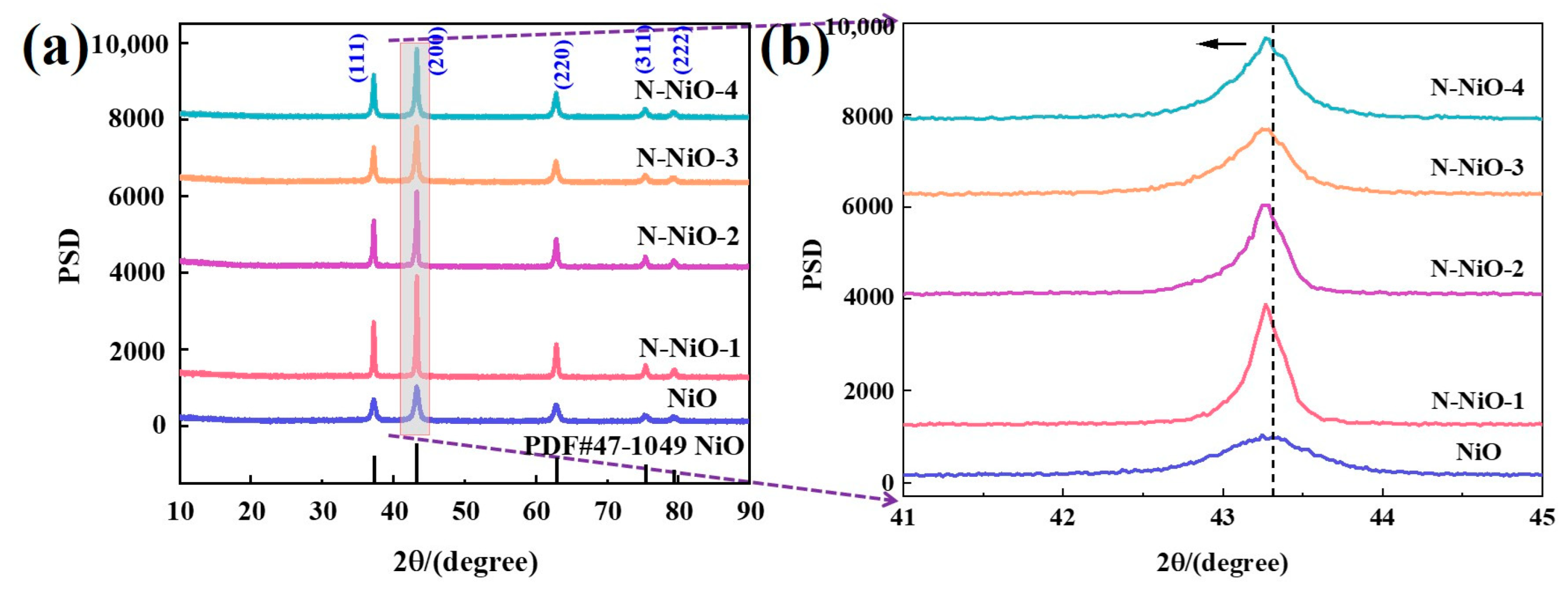
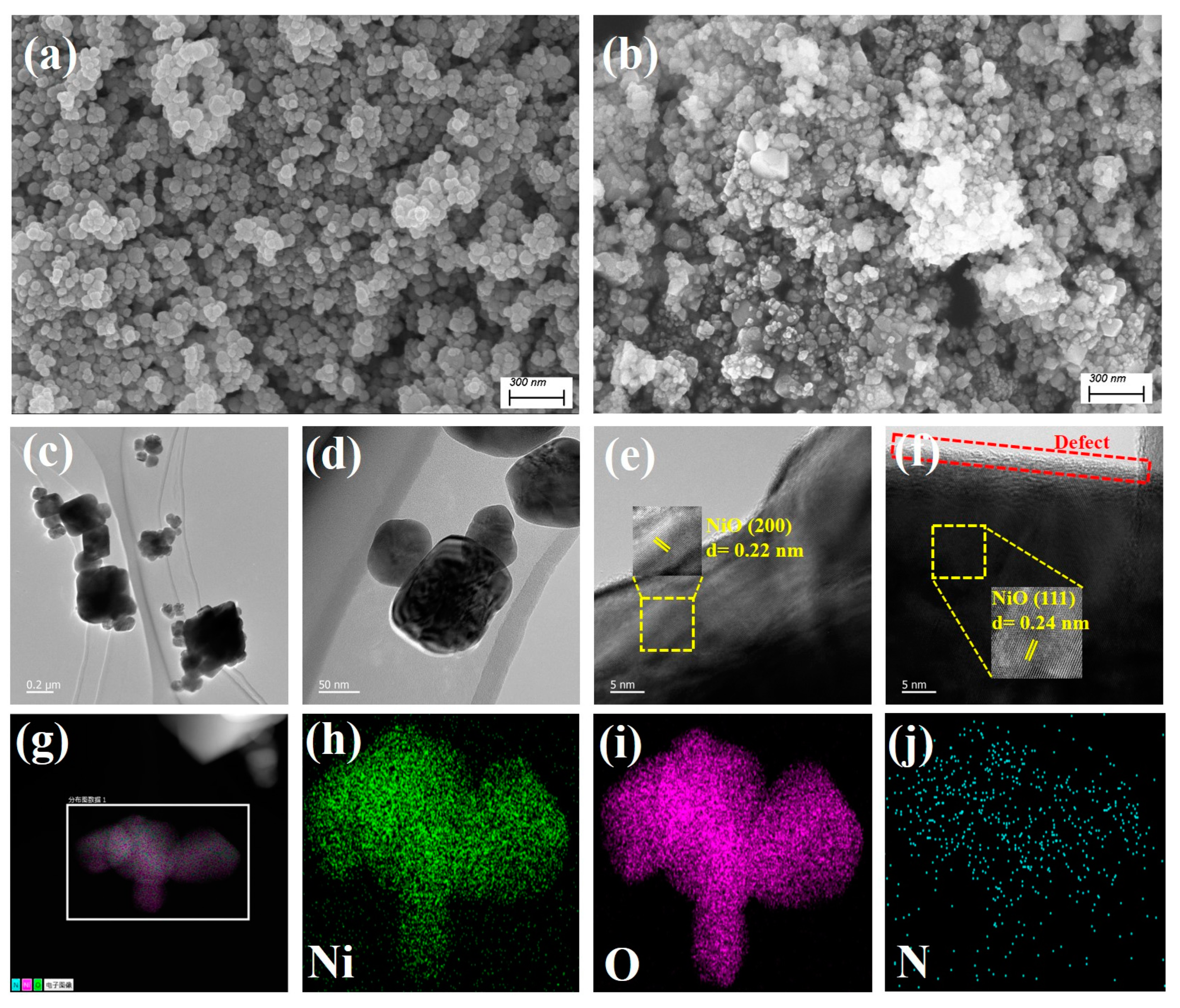
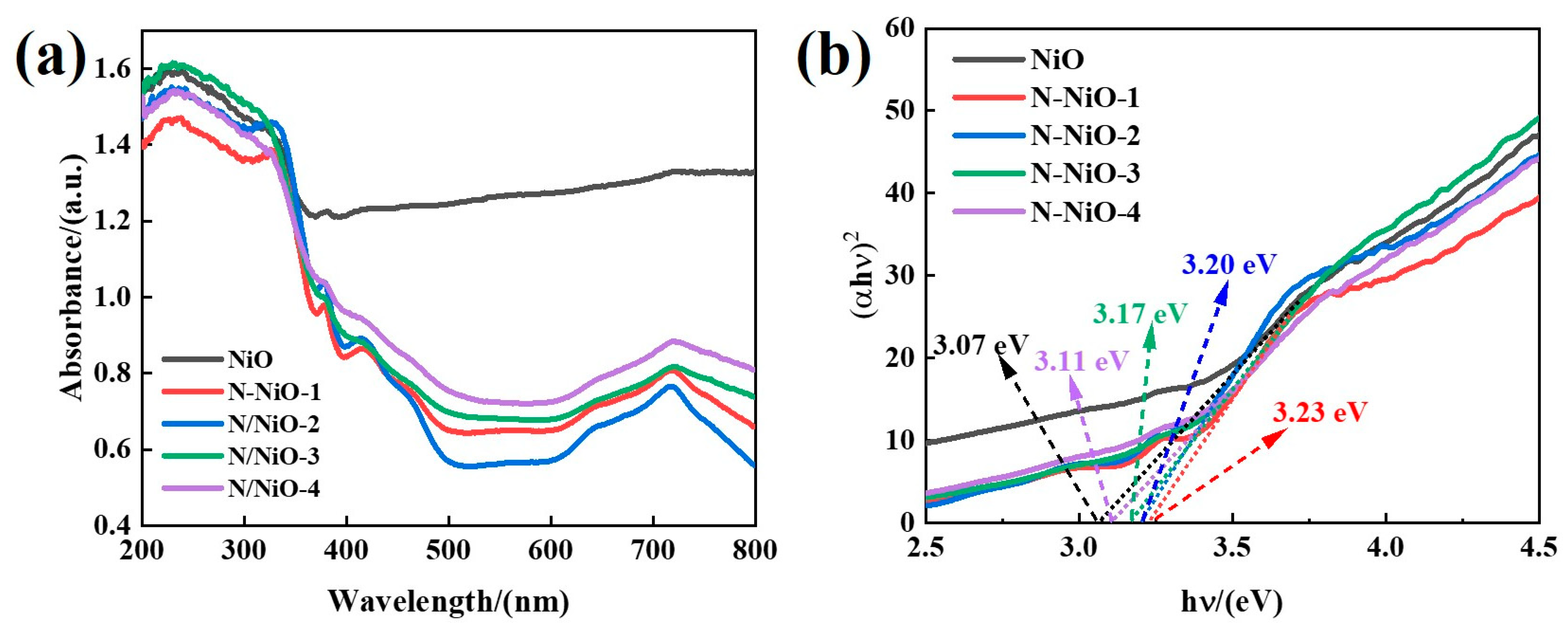
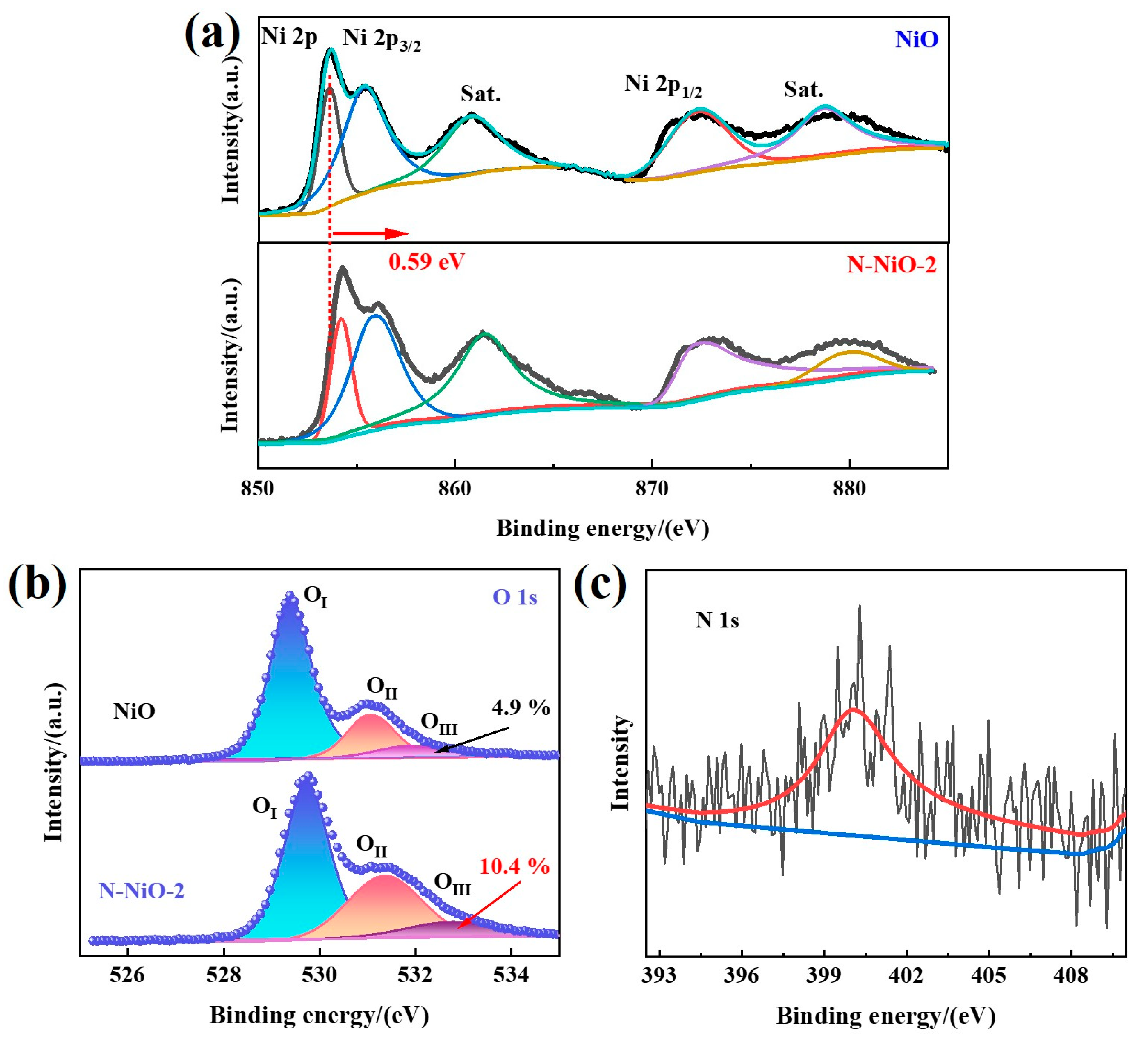
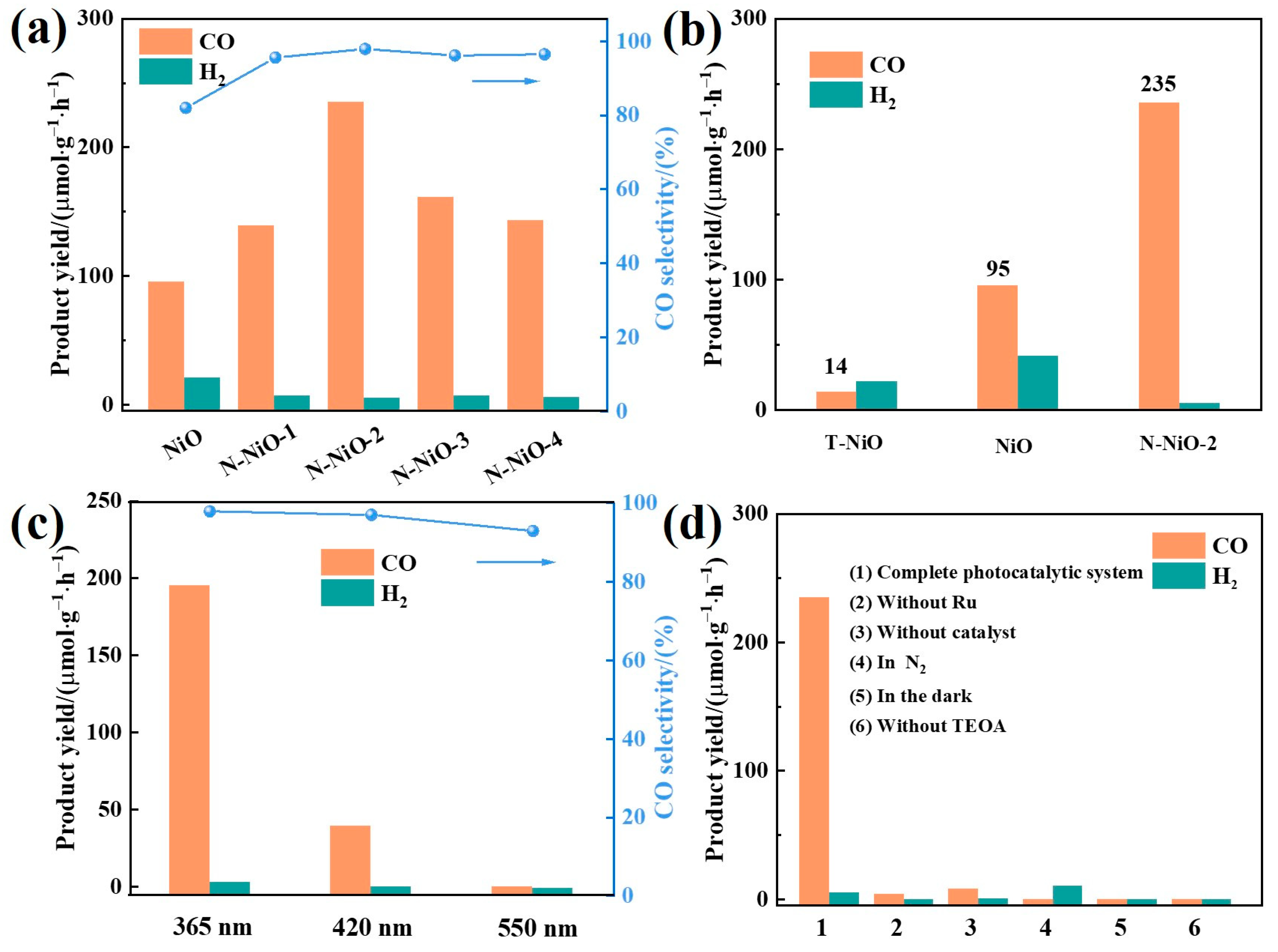
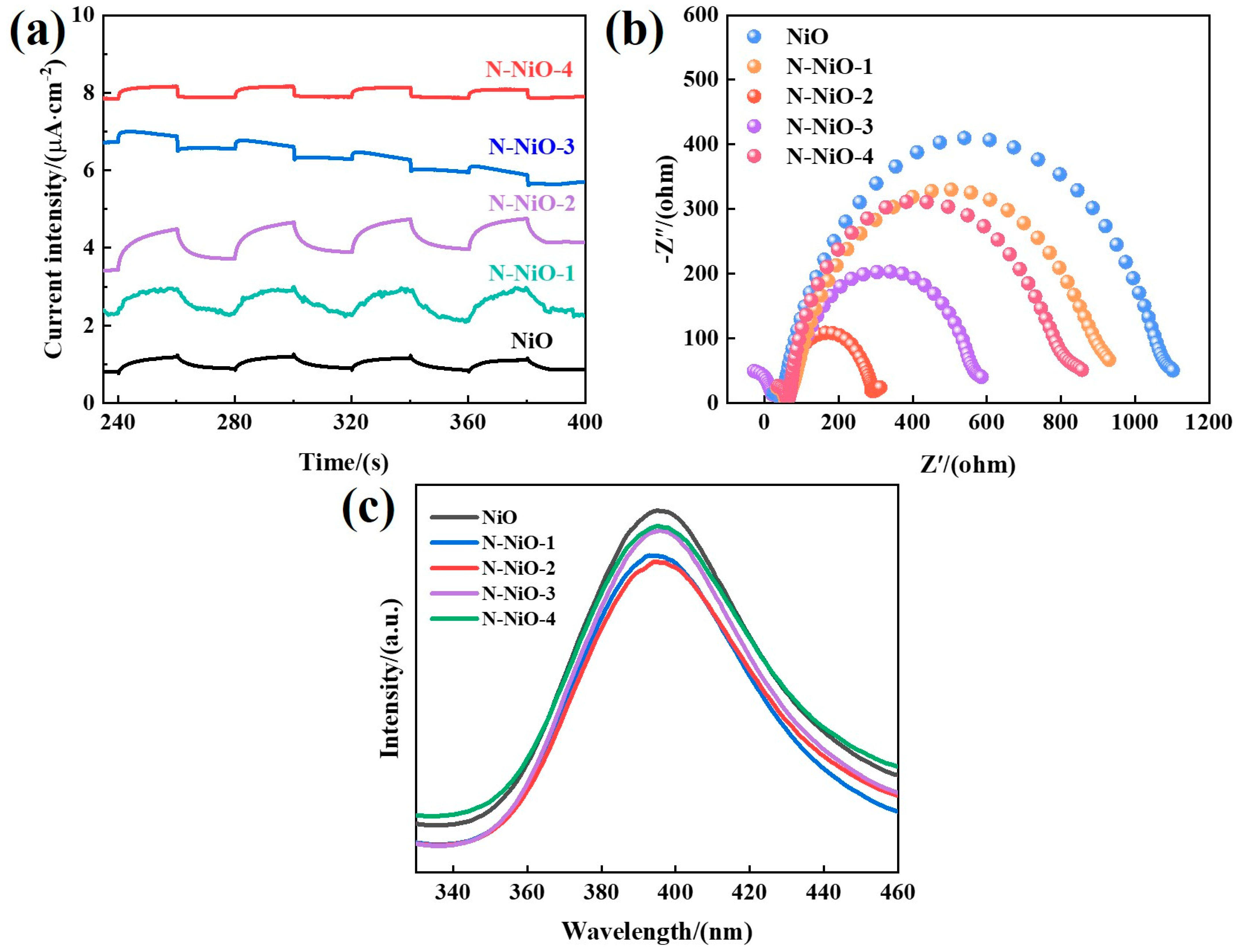
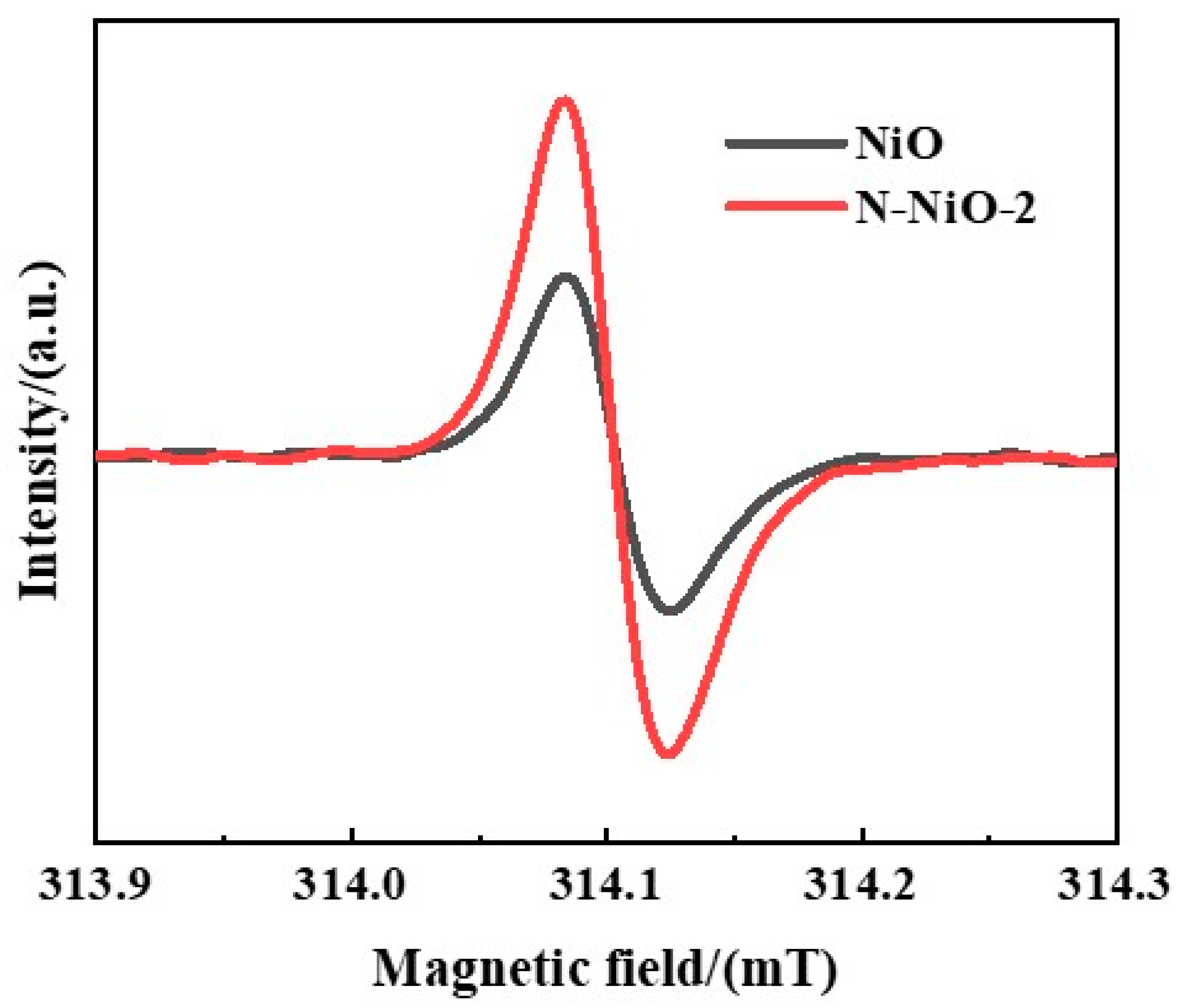
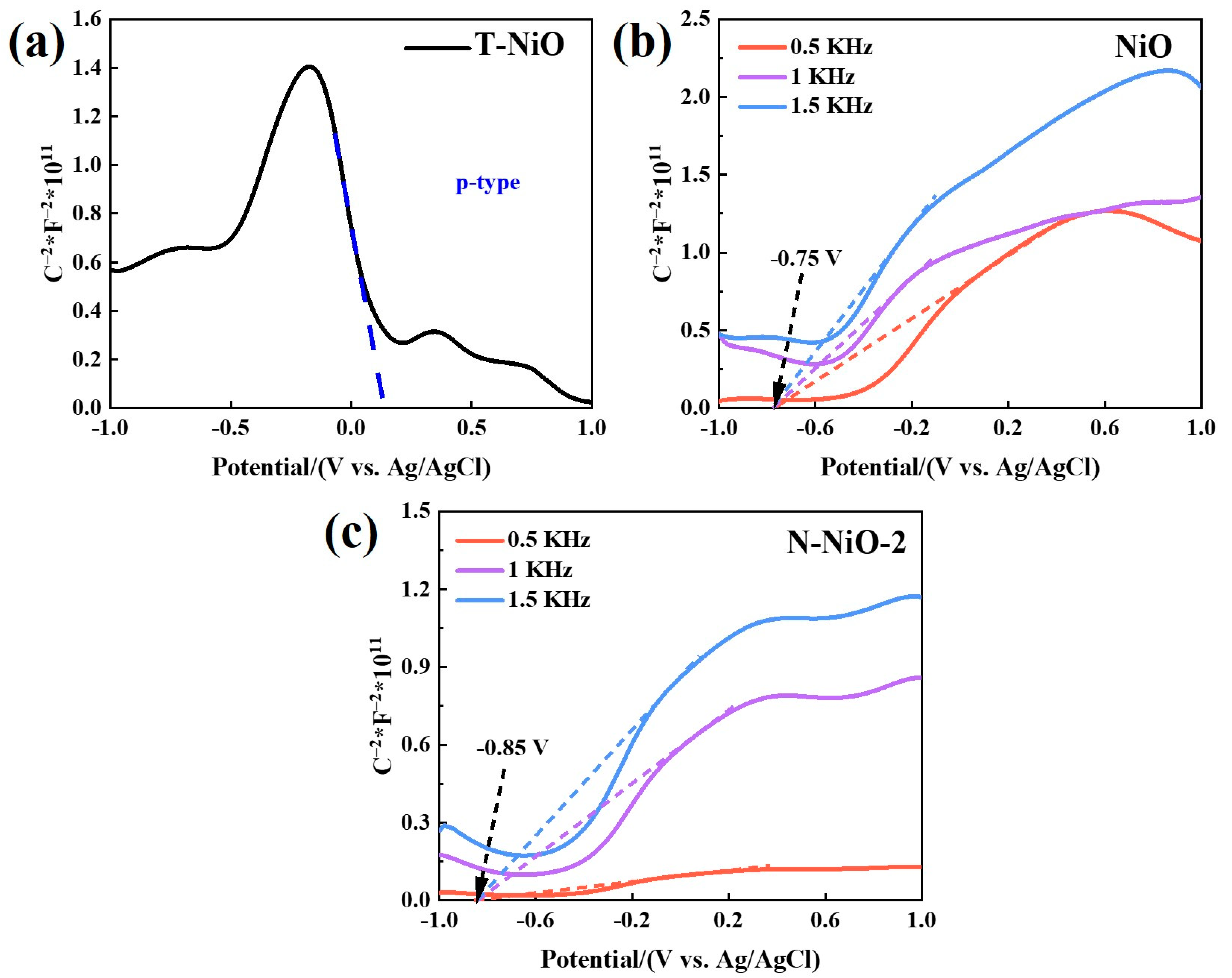
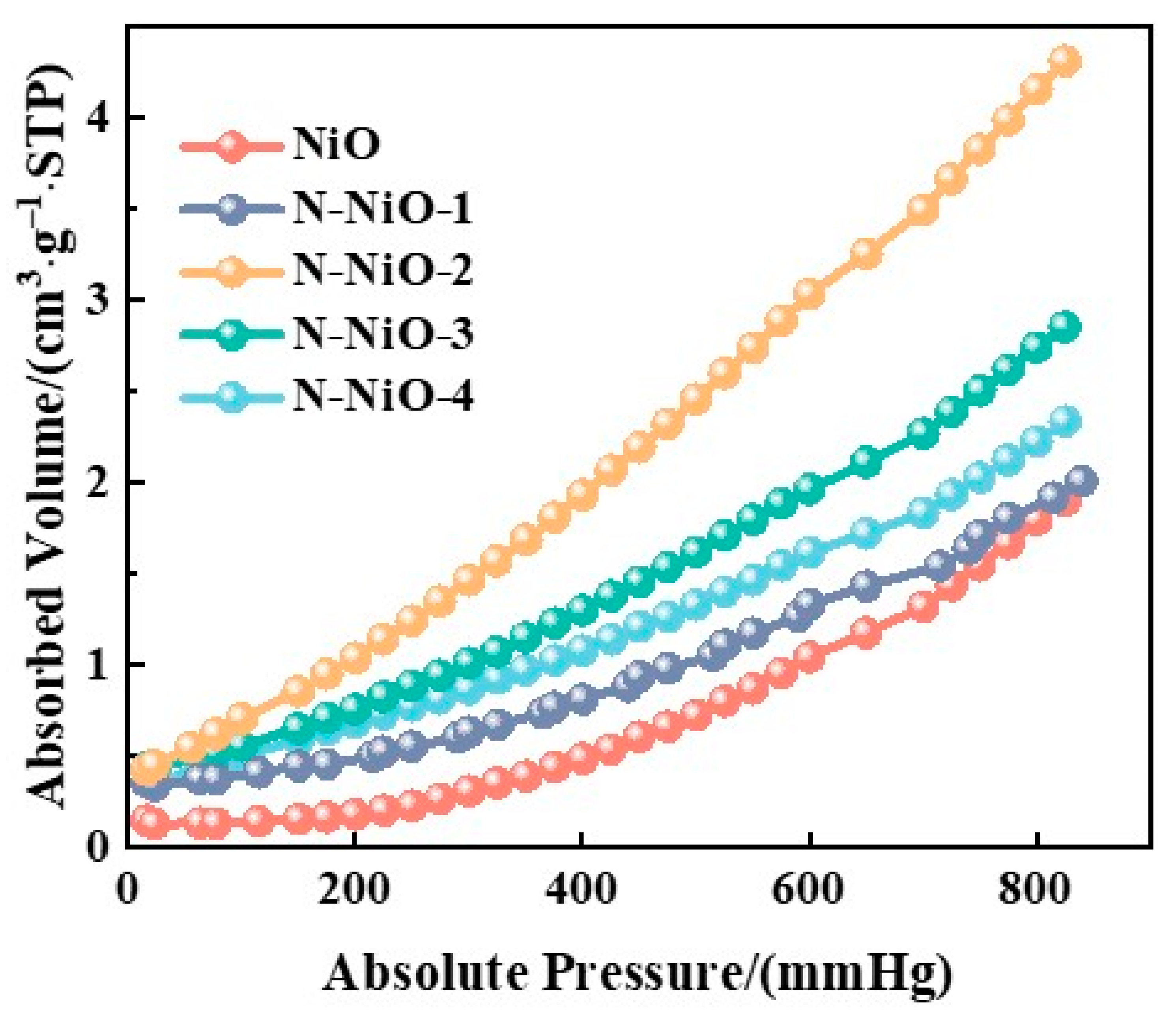

| Oxygen Species | Ni–O | O–H | OV | OV Ratio | |
|---|---|---|---|---|---|
| Samples | |||||
| NiO | 64,587 | 44,182 | 5635 | 4.9% | |
| N-NiO-2 | 67,586 | 73,293 | 16,352 | 10.4% | |
| Wavelength (nm) | Optical Power (mW) | CO Yield (μmol·g−1·h−1) | AQE (%) |
|---|---|---|---|
| 365 | 456.4 | 235.5 | 2.4 |
| 420 | 358.7 | 48.2 | 0.5 |
| 550 | 59.2 | 1.3 | 0.06 |
Disclaimer/Publisher’s Note: The statements, opinions and data contained in all publications are solely those of the individual author(s) and contributor(s) and not of MDPI and/or the editor(s). MDPI and/or the editor(s) disclaim responsibility for any injury to people or property resulting from any ideas, methods, instructions or products referred to in the content. |
© 2023 by the authors. Licensee MDPI, Basel, Switzerland. This article is an open access article distributed under the terms and conditions of the Creative Commons Attribution (CC BY) license (https://creativecommons.org/licenses/by/4.0/).
Share and Cite
Wang, F.; Yu, Z.; Shi, K.; Li, X.; Lu, K.; Huang, W.; Yu, C.; Yang, K. One-Pot Synthesis of N-Doped NiO for Enhanced Photocatalytic CO2 Reduction with Efficient Charge Transfer. Molecules 2023, 28, 2435. https://doi.org/10.3390/molecules28062435
Wang F, Yu Z, Shi K, Li X, Lu K, Huang W, Yu C, Yang K. One-Pot Synthesis of N-Doped NiO for Enhanced Photocatalytic CO2 Reduction with Efficient Charge Transfer. Molecules. 2023; 28(6):2435. https://doi.org/10.3390/molecules28062435
Chicago/Turabian StyleWang, Fulin, Zhenzhen Yu, Kaiyang Shi, Xiangwei Li, Kangqiang Lu, Weiya Huang, Changlin Yu, and Kai Yang. 2023. "One-Pot Synthesis of N-Doped NiO for Enhanced Photocatalytic CO2 Reduction with Efficient Charge Transfer" Molecules 28, no. 6: 2435. https://doi.org/10.3390/molecules28062435





